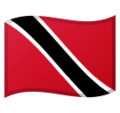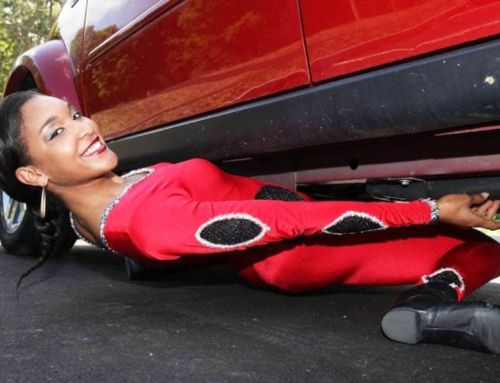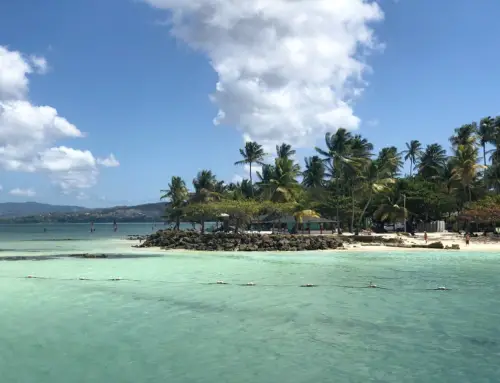Trinidad Flag – The National Symbol of Red, White and Black
The Trinidad Flag is a symbol of national pride and identity for the people of Trinidad and Tobago.
On the 28th of June 1962, an independence committee chose the flag design by the respected artist, Carlisle Chang.
His design of the flag was officially hoisted for the first time on Independence Day, August 31st, 1962 and is still the version in use today.
Table of Contents
Trinidad Flag Description
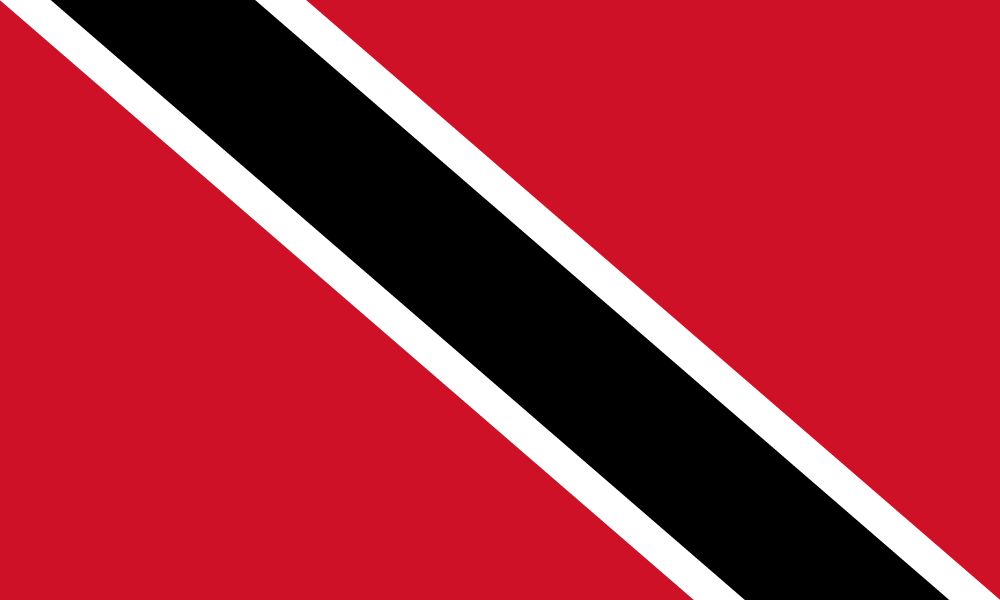
Trinidad and Tobago’s official description of its national flag, according to Part II of the National Emblems (Regulation) Act Chap.19:04 is as follows:
“On a Red Field, a Bend Dexter Sable bordered Silver; that is to say, there is on the Red Field a diagonal from left to right in Black bordered with White. The width of the Black and White
bands joined side by side at the Upper Dexter corner of the Flag is one-fifth of the full length of the Flag, and the width of each white band is one-sixth of the width of the White and Black
bands together. The width of the Black is therefore four-sixths of the total width of the White and Black.”
Trinidad Flag Specifications
Dimensions
The Trinidad and Tobago National Flag must comply with a specific size ratio to properly represent its significance:
- For Flags flown on land: five to three (5 : 3)
- For Flags flown at sea: two to one (2 : 1)
Colors
The colors of the Trinidad and Tobago National Flag are described as follows:
Red
HEX Color Code: #DA1A35
R-217 G-30 B-54
C-8
M-100
Y-85
K-1
Black
HEX Color Code: #000000
R-0 G-0 B-0
C-75
M-68
Y-67
K-90
White
HEX Color Code: #FFFFFF
R-255 G-255 B-255
C-0
M-0
Y-0
K-0
Trinidad Flag Meaning
The National Flag was selected from a series of designs created by the Independence Committee in 1962.
The colors of red, white and black were chosen to reflect the philosophy of a ‘new nation’, the principles for which it stood, its hopes and aspirations and the Nation’s supreme determination to preserve the harmony and unity of spirit which underlie the cultural diversity of their people.
Black represents the dedication of the people joined together by one strong bond. It is the color of strength, of unity of purpose, and of the wealth of the land.
White is the sea by which the lands are bound; the cradle of their heritage; the purity of their aspirations and the equality of all men under the sun.
Red is the color most expressive of the country; it represents the vitality of the land and its peoples; it is the warmth and energy of the sun, the courage and friendliness of the people.
Thus, the colors chosen – Black, White and Red – represent the elements of Earth, Water and Fire which encompass all our past, present and future; and inspire us as one united, vital, free
and dedicated people.
Flying the National Flag of Trinidad and Tobago
Special Days
The dates of special significance for Trinidad and Tobago on which the National Flag may be flown freely by all citizens are:
- Independence Day – 31st August
- Republic Day – 24th September
- Remembrance Day – 2nd Sunday in November
- Any other date that may be prescribed from time to time
Locations
President’s Residences
- The President’s Standard is a personal standard and should fly continuously, day and night, as long as His Excellency is in residence.
- The President’s Standard should be lowered as His Excellency leaves the grounds of his official residence only when he is to be away for the night. On such days when His Excellency is to be away for the night, his Standard is immediately upon his departure, replaced by the National Flag between the hours of 6.00 a.m. and 6.00 p.m. On His Excellency’s return, as he enters the grounds, his Standard is hoisted and the National Flag (if flying) lowered.
- When the National Flag is flown in place of the President’s Standard it should be lowered at 6.00 p.m. and hoisted again at 6.00 a.m. daily. The National Flag should be flown from the same mast as that used for the President’s Standard.
- On the special days of national significance, the National Flag should be flown together with the President’s Standard to the left of it and at the same height on a separate flagstaff. When the National Flag is flown with the President’s Standard, it should be hoisted at 6.00 a.m. and lowered at 6.00 p.m.
- The President’s Standard being a personal standard, should never be flown at half-mast except in the event of the death of the President. When occasion requires that a flag be flown at half-mast, the National Flag should be used.
Prime Minister’s Official Residence
The National Flag should be flown daily from 6.00 a.m. to 6.00 p.m. at the Prime Minister’s official residence.
Government Buildings
The National Flag should be flown daily during working hours on or in the precincts of important Government Buildings. On the special days for the display of the Flag, the Flag should be from 8.00 a.m. to 6.00 p.m.
Educational Institutions
The National Flag should be flown on school days on or in the precincts of all state and state-aided educational institutions from 8.00 a.m. to closing time. On the first day of the term
the flag should be ceremonially hoisted and, on the last day, ceremonially lowered. In this context the term “ceremonially” should be taken to mean in the presence of all the students assembled, and with the singing of the National Anthem.
Motor Cars
The under-mentioned persons may, besides their own distinctive flags, fly the National Flag on their official or private cars when occupied by them for travelling on official duty: at other times
the National Flag on such cars should be removed or sheathed.
- The Prime Minister
- The President of the Senate
- The Speaker of the House of Representatives
- Members of the Cabinet
- Heads of the Country’s Permanent Overseas Missions.
The National Flag should be on a staff firmly affixed to the right front fender of the car, whilst the Prime Minister’s or Minister’s Flag is flown on the left front fender of the car. The staff must be of sufficient height to ensure that the respective flags do not touch the body of the car.
Overseas Missions
At overseas establishments of the Government of the Republic of Trinidad and Tobago, the National Flag should be flown daily unless this is contrary to the law or custom of the country in which the Mission is located. In any event, the Flag should be flown on the special days specified above and on such other special occasions as may be prescribed by the responsible Minister.
Proper Usage of the Trinidad and Tobago National Flag
Hoisting and Lowering of the Flag
The Flag should be hoisted briskly to the top of the staff, care being taken to ensure that it occupies the correct position on the halyard, the right upper corner of the flag being at the peak of the staff.
The Flag is to be lowered slowly and with dignity.
Paying Respect to the Flag
While the National Flag is being raised or lowered or while it is passing in a parade or review, all persons should pay respect it by standing at attention and facing the Flag. Men in civilian dress should remove their hats. Persons in uniform should salute. The Defense Force Colors should receive the same respect.
Standards, ensigns or emblems of institutional or voluntary organizations need only to be paid respect by members of the institutions or organizations according to their individual customs.
Displaying the Trinidad Flag with Other Flags and Emblems
- Within Trinidad and Tobago and also at its Overseas Missions, no other flag, color, standard, ensign, or other emblem should be displayed above or to the right of the National Flag, that is, the Flag’s own right, or the observer’s left. All other flags flown together with the National Flag of the Republic of Trinidad and Tobago should be placed to the left of it.
- When the flags of two or more nations are displayed together they are to be flown from separate staffs of the same height and all the flags should be as far as possible of the same size. International usage forbids the display of the flag of one nation above that of another in time of peace.
- When the National Flag is flown with other flags it must be the first to go up and the last to come down. It must never be lowered while other flags are flying or are being hoisted.
- When the National Flag is flown in a group with local flags, standards, ensigns, or emblems, such as those belonging to our Townships, institutions, societies, and organizations, it should be at the center and at the highest point in the group.
- When the National Flag or any other flag or flags are displayed from crossed staffs against a wall, the National Flag should be on the right (the flag’s own right), with its staff placed in the front of any other staff or staffs as the case may be.
Display of the T&T Flag in a Horizontal Position or at an Angle
When the flag is displayed from a staff projecting horizontally or at an angle from a window sill, balcony, or the front of a building, the Upper Dexter quarter of the flag (or more simply, the top right corner of the flag) should go clear to the peak of the staff provided the flag is not being displayed at half-mast.
Display of the Flag Without a Staff
- When the Flag hangs over a sidewalk from a rope extending from house to a pole standing at the edge of the sidewalk it is displayed vertically with the Upper Dexter quarter towards the pole.
- When the Flag is being displayed but not flown from a staff, it should be displayed flat and fully extended, whether indoors or out, or so suspended that its folds fall as freely as if the Flag was staffed.
- When the Flag is displayed over a street it should be suspended vertically with the Upper Dexter (right) quarter to the North in an East-West Street or to the East in a North-South Street.
Display of the Flag in a Parade
- The National Flag should not be carried flat or horizontally, but always aloft and free, and borne to the front and middle of the Stand-bearer.
- The National Flag when carried abreast in a procession with another flag or with other flags should be on the marcher’s right (the right being the position of honor) with the other flags to the left of it. If the procession takes the form of a line of flags, the National Flag should be at the front of the center of that line.
- The salute to the Flag in a moving column by those present in uniform should be rendered at the moment the Flag passes.
- When the Flag is displayed from a float or motor car the staff should be securely clamped to the chassis or the right fender.
- The Flag should not be draped over the hood, top, sides, or back of any vehicle, railway train, or boat.
- The National Emblem Committee should guide the display of the National Flag at Parades.
Display of Flag in Church
The Trinidad Flag if used in the chancel of a church should be borne on a staff at the clergyman’s right as he faces the congregation. Any other flags should be placed on his left. When displayed on a staff in a chapel in front of the chancel, or in the body of the church, it should be flown from the congregation’s right facing the chancel or platform; any other flags in the body of the church should be to the left of the congregation.
Display of Flag at Public Meetings
- When used on a rostrum, the Flag should be placed, if displayed flat, behind the speaker and high above his head and above all other decorations, and in its normal position as when it flies from a staff; i.e. the Upper Dexter quarter should be uppermost and form the right side of the flag as it faces the audience.
- When the Flag is displayed from a staff on a speaker’s platform, it should be placed at the speaker’s right in the position of honor. If displayed in the body of the auditorium, facing the platform, it should fly from a staff at the right of the audience. Other flags in the body of the auditorium should be displayed from staffs standing to the left of the audience facing the speaker.
- The National Flag must not be used to cover a speaker’s desk or be draped in front of the platform.
Display at the Unveiling of Monuments
The Flag may be displayed at the Ceremony of unveiling a statue or monument, but on such occasions, it should not be used to cover the statue or monument.
Display at Funerals
The National Flag may be used at official funerals. It is draped over the coffin with the Upper Dexter quarter at the head and over the left shoulder of the deceased. The Flag is secured at the four corners. It should be removed before the coffin is lowered into the grave and should not be allowed to touch the ground.
These rules also apply to a burial at sea.
Display in Mourning: Half-mast
The National Flag is flown at half-mast (or half-staff) when the Nation is in mourning. Half-mast refers to the lowering of the Flag by its own depth from its normal position at the peak of the staff.
When the Flag is flown at half-mast, it is first hoisted to the top of the staff for an instant, then lowered to the half-mast position. Before lowering for the day the Flag is again raised to the top of the staff.
The Flag should be flown at half-mast on the day of the death and also the funeral day of:
- The President
- The Prime Minister
- The President of the Senate
- The Speaker of the House of Representatives
- Members of the Cabinet
- Other notable citizens and residents of the Republic of Trinidad and Tobago as may be announced by the Minister of National Security.
- On other occasions as may be prescribed by the Minister of National Security.
When any of these days of mourning on which the Flag is required to fly at half-mast falls on one of the special days of national significance, the National Flag should nevertheless be flown at full mast on that day, unless special instructions to the contrary are received from the Minister of National Security.
Display at Night
The National Flag may be displayed in the open after sunset when it should be floodlit if possible.
Display on Coast Guard Vessels
On Coast Guard vessels, flags will be flown in the following manner:
- When in harbor, daily from 8.00 a.m. to sunset, the National Flag at the bow and the Coast Guard ensign at the stern.
- When at sea, by day or night, the Coast Guard ensign at the stern.
- At all times whilst the vessel is in commission on a commissioning pendant at the mast head.
Prohibited Used of the Trinidad and Tobago National Flag
- The National Flag must not be dipped to any person or thing; this honor will be rendered by the Defense Force Colors or where appropriate by the flags of the institutions, organizations etc.
- The National Flag should not be used for purposes of adornment or advertising. It should not be printed or embroidered or otherwise reproduced on such articles as handkerchiefs, uniforms or clothing of any kind, or furniture, cushions, etc. It should not be printed or otherwise impressed on paper boxes or napkins or anything intended for temporary use and discard. It should not be used as any part of a disguise costume.
- The Flag should not have placed on it or attached to it any mark, insignia, letter, work, figure, design, picture or drawing. It should not be used as a commercial trade mark. Advertising signs should not be fastened to a staff or halyard from which the National Flag is flown.
- The Flag should not be used as a receptacle for receiving, holding, carrying or delivering anything.
- The Flag should not be festooned over doorways, arches, etc., or tied in a bowknot, or fashioned into a rosette, or used as draping. It should not be drawn back or drawn up in folds but always allowed to fall free.
- The Flag should not be displayed, used or stored in such a manner as would permit it to be easily torn, soiled or damaged in any way.
- The Flag should not be used as a covering for a ceiling.
- The Flag should not be allowed to touch anything beneath it, such as the ground, the floor, water or merchandise.
Trinidad Flag FAQs
Can regular citizens fly the Trinidad and Tobago National Flag?
Citizens at private residences may fly the National Flag from 6:00AM to 6:00PM or outside of this time provided the flag is well lit.
Who designed the Trinidad and Tobago Flag?
Mr. Carlisle Chang designed the current Trinidad and Tobago flag in 1962.
Carlisle Chang was born in 1921 in San Juan to a Chinese migrant father and a British Guiana mother of Chinese ethnicity.
Growing up in an ethnically diverse community played a major role in shaping his style and work in art.
Prior to being given independence 1962, Carlisle Chang was already known for designing the Coat of Arms for the Federation of the West Indies in 1958.
When Trinidad and Tobago became an independent country in 1962, Carlisle Chang designed the Trinidad and Tobago flag as we still know it today.
Carlisle Chang passed away in 2001, at the age of 80 after a lifelong career that influenced art history in his homeland of Trinidad and Tobago.
Was this the first Trinidad flag?
The current flag is not the first Trinidad flag.
The first Trinidad flag was the colonial Trinidad flag, which was given to the islands during their time in the British Empire. The flag resembled many other colonial flags with a solid blue field that was decorated with the Union Jack in the flag’s canton and the seal of Trinidad and Tobago in the fly. That seal depicted a ship arriving in port near a mountain in tribute to the geography of the islands.
That flag served as the Government Ensign of Trinidad and Tobago from 1889 to 1958.
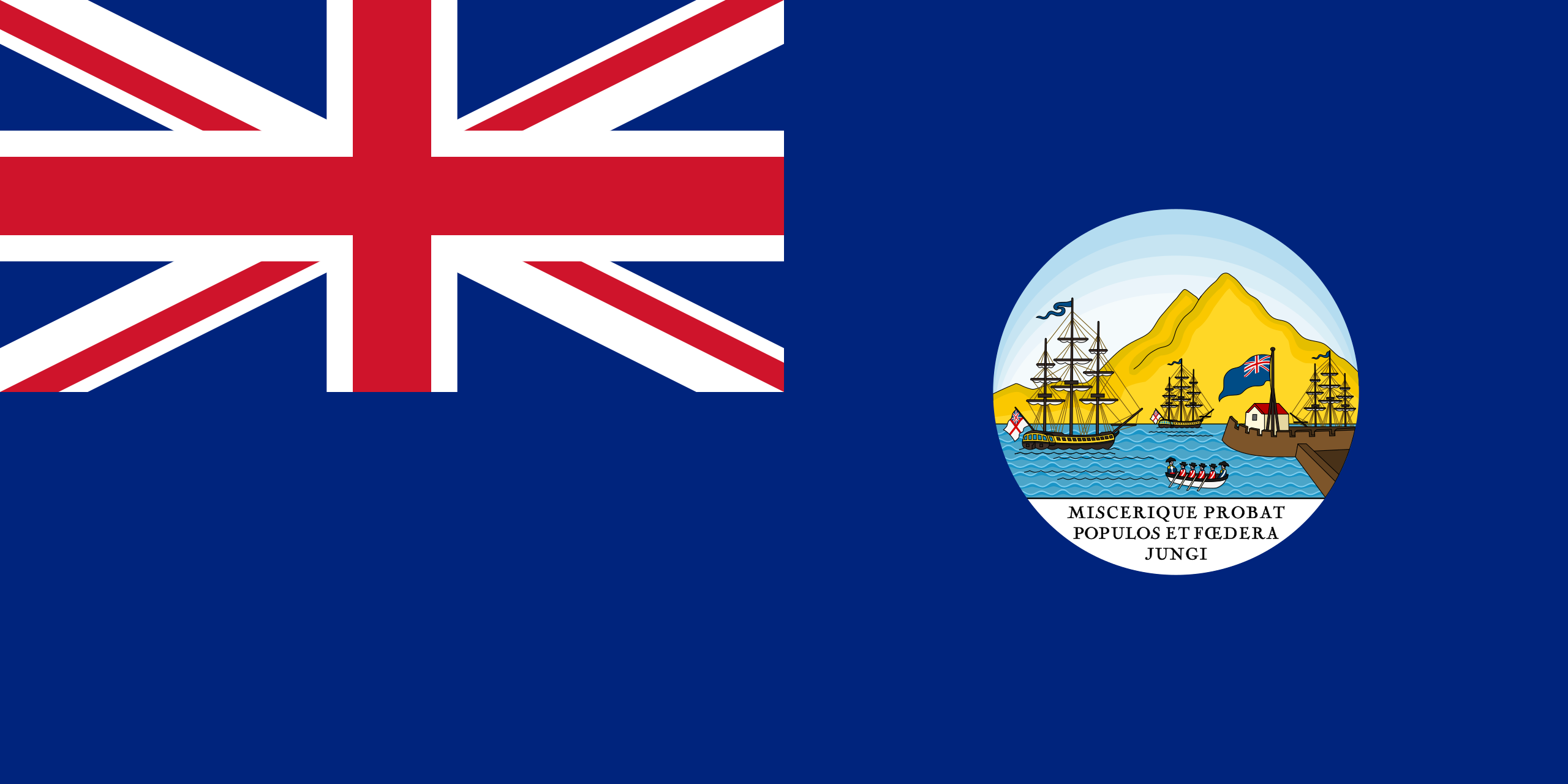
The Colonial Trinidad Flag
How to use the Trinidad Flag Emoji?
The Trinidad and Tobago flag emoji can be used on mobile devices via the code: 🇹🇹
Get the full list of emoji icons for the Trinidad Flag Emoji on Emojipedia
Is there a Trinidad Flag to Color for Students?
The Trinidad and Tobago flag is available below in a coloring book form that can be colored in using color-pencils or crayons.
This is an excellent resource for assist young students to learn the red, white and black flag meaning.
Right-click to download and print it.
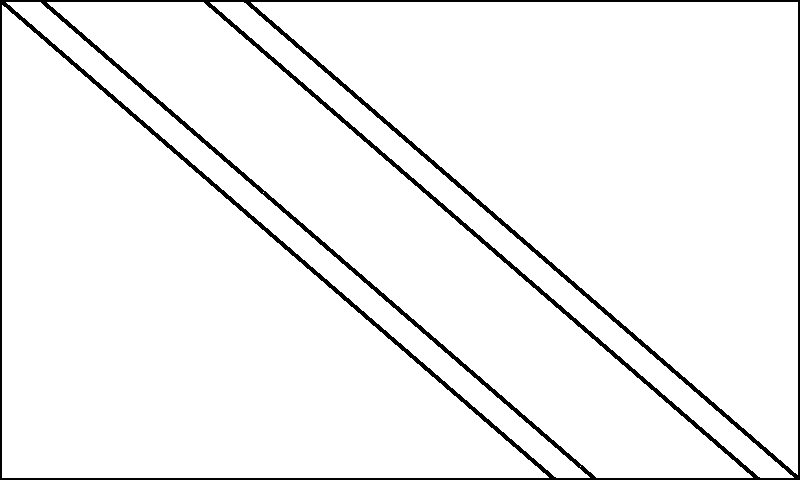
Can anyone make and sell the Trinidad flag?
A license must be acquired to reproduce and sell the National Flag. Customs has the authority to seize unauthorized and inconsistent National T&T Flags coming into the country.
References
National Archives of Trinidad and Tobago
National Identity Guidelines
The Office of the President of the Republic of T&T
National Emblems
Ministry of Foreign and CARICOM Affairs
National Flag
NALIS
National Flag

